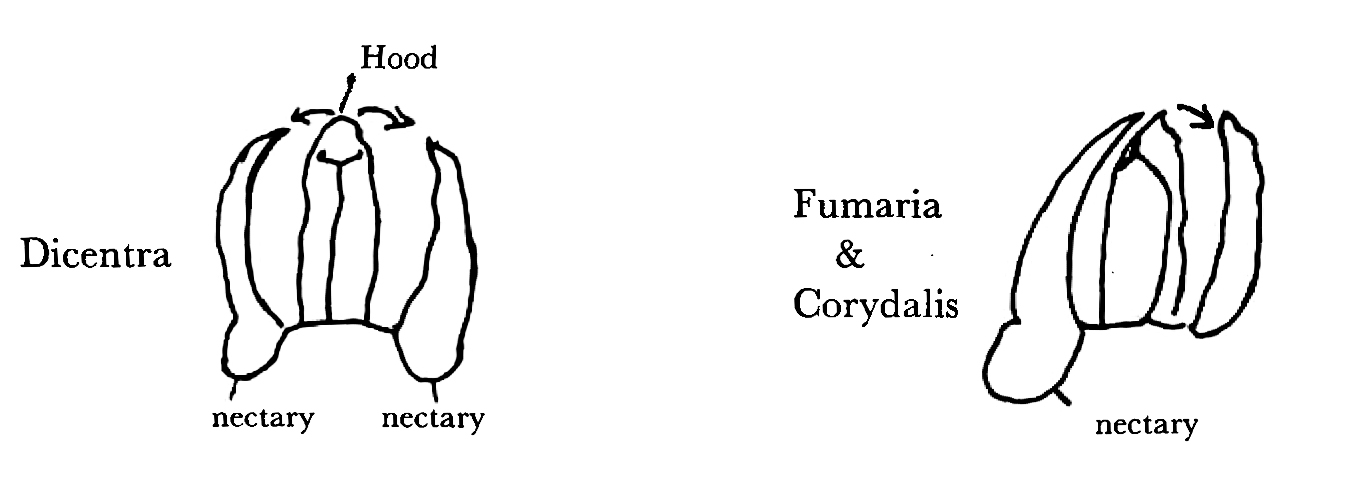To Asa Gray 4 July 1858
Down Bromley Kent
July 4th.— 1858
My dear Gray
I have not answered your note of May 21 for I have had death & illness & misery amongst my children.1 And we are all going immediately from home for some weeks.2
With respect to Dicentra it is really pretty to watch the Humble Bees sucking first on one or the other side of the several flowers; with their hind legs resting on the crests of the hood formed by the inner united petals they push it to opposite side of flower, & the straight pistil is rubbed against their abdomens & inner side of thighs, which are white with pollen from the several flowers. It is impossible but what the individuals of Dicentra must be largely crossed. Your Adlumia has not flowered with me yet. In Fumaria & Corydalis we have another structure, viz nectary on one side & here the pistil bends so that the 2 stigmas are presented in the gangway to the one nectary; & the hood slips off easiest in opposite direction, instead of equally easily to either side.
 Indeed, in Corydalis lutea it almost springs off, & the pistil decidedly springs towards the nectary-bearing petal. I have observed only 6 Fumariaceæ, & I wish that I knew whether the rule was general; for I must believe that the structure of these flowers is related directly to the visits of Bees.3
Indeed, in Corydalis lutea it almost springs off, & the pistil decidedly springs towards the nectary-bearing petal. I have observed only 6 Fumariaceæ, & I wish that I knew whether the rule was general; for I must believe that the structure of these flowers is related directly to the visits of Bees.3
I suspect from my own few observations that the following rule may be gen-eralised (& I shd. much like to know whether it is true) that when honey is secreted on one point of circle of corolla, the pistil if it bends, always bends so that the stigmas, when mature, lie in the gangway to nectary. Thus in Columbine where there is a circle of nectaries, the stigmas are straight; in Aquilegia grandiflora where there is one nectary, the stigmas are rectangularly bent so that every Bee (as I this day saw) brushes over them in extracting the honey.—
It is very unlikely, but if by any chance you have my little sketch of my notions of “natural Selection” & would see whether it or my letter bears any date, I shd. be very much obliged.4 Why I ask this, is as follows. Mr. Wallace who is now exploring New Guinea, has sent me an abstract of the same theory, most curiously coincident even in expressions.5 And he could never have heard a word of my views. He directed me to forward it to Lyell.— Lyell who is acquainted with my notions consulted with Hooker, (who read a dozen years ago a long sketch of mine written in 1844) urged me with much kindness not to let myself to be quite forestalled & to allow them to publish with Wallace’s paper an abstract of mine; & as the only very brief thing which I had written out was a copy of my letter to you, I sent it and, I believe, it has just been read, (though never written, & not fit for such purpose) before the Linnean Socy.;6 & this is the reason, why I shd. be glad of the date. But do not hunt for it, as I am sure it was written in September, October or November of last year.—
I have troubled you with a long story on this head; so pray forgive me & believe me | Yours very sincerely | C. Darwin.—
P.S | In regard to bent pistils & nectaries, I shd. say that I largely judge of position of nectary, by seeing where Bees suck; according to this, the rule holds in all Leguminosæ, in my 6 Fumariaceæ, in Polygala.—Viola tricolor, Dictamnus Æsculus, Rhododendron—Aquilegia.
Footnotes
Bibliography
Correspondence: The correspondence of Charles Darwin. Edited by Frederick Burkhardt et al. 29 vols to date. Cambridge: Cambridge University Press. 1985–.
Wallace, Alfred Russel. 1905. My life: a record of events and opinions. 2 vols. London: Chapman & Hall.
Summary
Believes that, in Dicentra, Fumaria and Corydalis, flower structures are related directly to visits from bees. Flower stigmas generally are placed in the path of bees.
Has received paper from Wallace on natural selection; has sent abstract of his notions, with Wallace’s paper, to Linnean Society.
Letter details
- Letter no.
- DCP-LETT-2302
- From
- Charles Robert Darwin
- To
- Asa Gray
- Sent from
- Down
- Source of text
- Archives of the Gray Herbarium, Harvard University (20)
- Physical description
- ALS 6pp
Please cite as
Darwin Correspondence Project, “Letter no. 2302,” accessed on
Also published in The Correspondence of Charles Darwin, vol. 7


